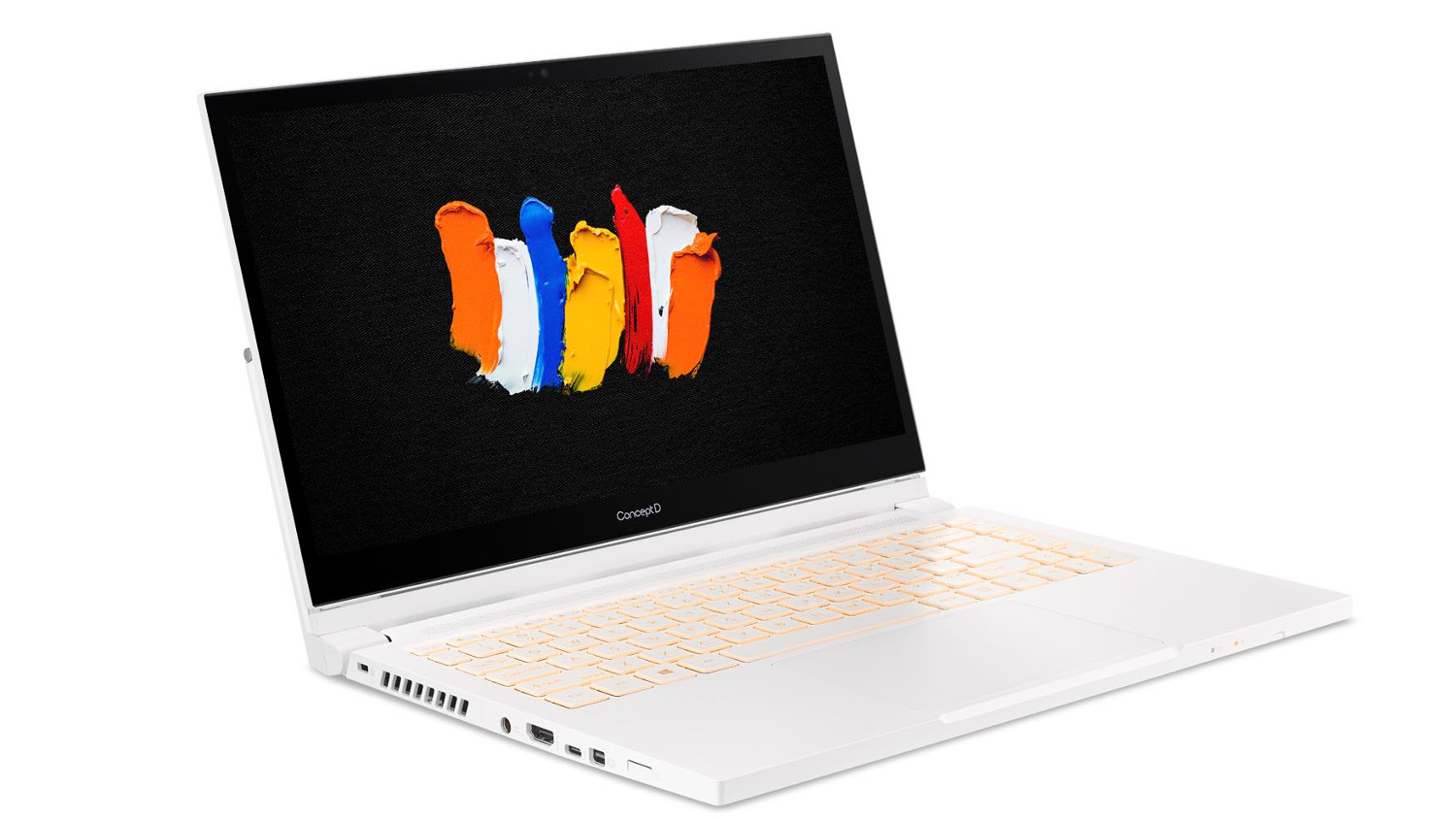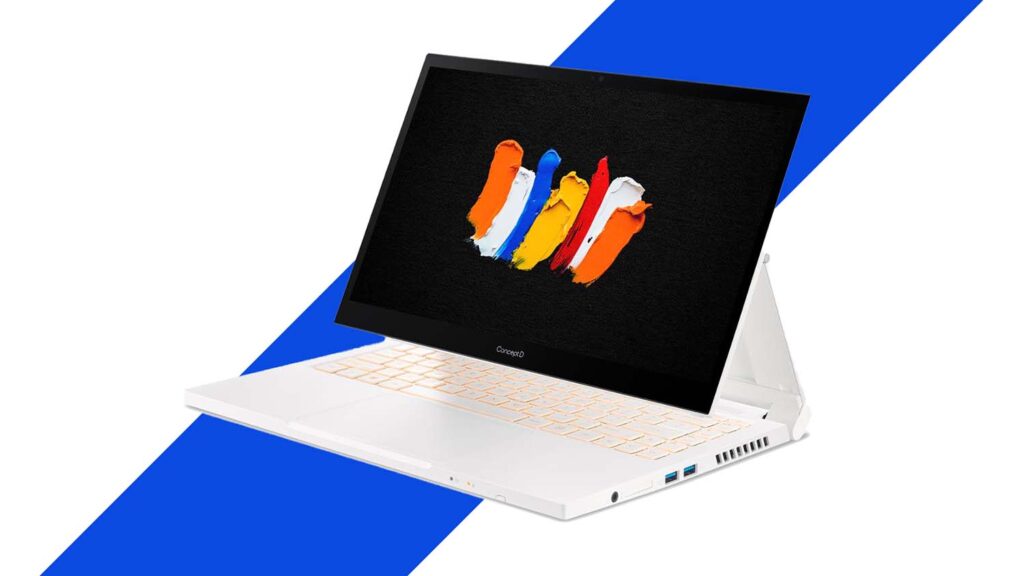Acer is looking to address the creative market with its ConceptD range. Al Dean takes a look at one of the mobile offerings in a range that promises power with flexibility
A well-known brand in the consumer and gaming space, Acer isn’t typically associated with professional workstations. The company is looking to change that, however, with its ConceptD range, which owes much to the success Acer has experienced with its Predator line of gaming PCs.
The ConceptD range includes a number of striking desktop workstations, the design of which reflects a determined step away from the typical black-and-silver box – but it’s the ConceptD Ezel laptop range that interests us the most.

While sizes and specifications vary, what all the products in the range have in common is the Ezel hinge.
This double hinge gives you more flexibility for opening and closing the unit, compared to a standard single hinge.
What this means is that the display can be easily adjusted: from a standard laptop configuration, the display can also be pushed upwards if you’re using a connected keyboard and mouse; flipped over for a presentation (with the display adjusting automatically); or it can lie flat for use as a drawing surface.
As you might guess, all machines are equipped with Wacom’s pen-based input, so they’re perfectly suited to those who like to switch to that mode for certain workflows and tasks.
The machine reviewed here is the smallest from the range, the ConceptD 7 Ezel. It’s built around a 15-inch, 4K screen and weighs in at just 1.86kg. The combination of an aluminium/magnesium chassis, along with some pretty terrifying white casing, makes for a striking and sturdy unit.
The all-important ports are found on either side of the machine. These include USB 3 and C, as well as HDMI connectivity for external displays. (It’s just a single HDMI, but you can also drive a monitor using DisplayPort over USB-C.)
ConceptD 7 Ezel – In use
The Acer ConceptD range is interesting. It moves from pretty standard laptops to more interesting devices, both in terms of performance at the high end and in terms of usability options. And while it might sound a little counterintuitive having the combination of an adjustable touchscreen display, keyboard and pen-based input in a single device is compelling.
I’ll give you an example: using Fusion 360 on this machine. With pen in hand, you can draw out geometry when needed and use the keyboard to input numbers and hotkeys as well as type. But you can also use your finger to rotate/pan/zoom your model. What amazed me was how quickly I got accustomed to this mix of interaction types.
As a laptop, it’s pretty much as you might expect. It offers a decent GPU for a machine of its size, it doesn’t run too hot, and the keyboard is responsive. We ran the KeyShot Viewer benchmark and found that while it fared averagely on the CPU count, it punched way above its weight when it came to GPU rendering – but only after we installed updates to Nvidia’s Studio drivers.
The real sweet spot was using the ConceptD 7 Ezel as a drawing tablet with pen-based input. Wacom’s EMR technology keeps things responsive, the pen nib tracks well and there was very little latency. (It’s also worth noting that Wacom’s EMR tech isn’t swapped out for its more budget-conscious AES tech at the lower end of this ConceptD Ezel range.)
In particular, the ability to pull the display closer and position it as needed was very useful, especially if you’re working in a less-than-ideal space (at a kitchen table, perhaps) or while on the move. The hinge mechanism felt robust at all times – but only time will tell how it stands up under longterm, regular use.

Conclusion
The portability of the Acer ConceptD 7 Ezel is pretty handy and its combination of a decent (albeit consumer-level) GPU with pen-based options is intriguing.
It opens up, for example, the opportunity to consolidate on a single unit for those of you who regularly find yourselves lugging around multiple devices – even if, right now, that’s only from your living room to your bedroom, or vice versa.
Performance-wise, the unit we reviewed (the RTX 2070) wasn’t top of the line, even within the ConceptD 7 line-up. It would probably suit only light-duty CAD work.
That said, for GPU-based workflows, such as rendering, it doesn’t disappoint. I’d personally recommend a minimum of 32GB of RAM to bring it up to par.
Other options are available and you should assess the full product range according to your specific needs. In terms of my other thoughts on this product, it’s worth mentioning that the white finish is going to appeal to a certain type of person – and it’s probably fair to assume that that person won’t be somebody who regularly gets their hands dirty in the course of their work.
In other words, if you’re involved in building prototypes in the design office or working on the shopfloor, this machine may be best avoided. It will be filthy in seconds.
You may also want to get yourself a full-size EMR stylus – and there are many available. For comfort, I’d recommend Lamy’s Safari EMR pen.
All in all, the Concept 7 Ezel shows that Acer is looking to take the creative market seriously. With this clever multiuse device, it will likely find an eager audience there.
ConceptD 7 Ezel – Specifications
» Intel Core i7-10875H 2.33Ghz (8 core) CPU
» Nvidia GTX 2070 Max-Q Design (8GB) GPU
» 16GB DDR4 SDRAM memory
» 15.6” 4K Pantone validated display
» EMR pen & touchpad input
» 1TB PCI Express SSD
» Aluminium/ Magnesium chassis with ceramic microcoat panels
» Dimensions: 326mm (l) x 229mm (w) x 23.9mm (h)
» Microsoft Windows 10 Professional 64-bit
» 1.68kg
» 3 Years standard warranty (return to base) – upgradeable to on-site £2,399 (Ex. VAT)






